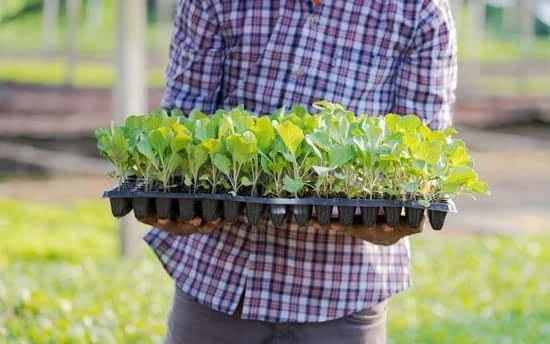Are you interested in gardening vegetables by season? The practice of planting and harvesting vegetables according to the seasonal changes offers numerous benefits and is essential for a successful garden.
Understanding the best times to plant and harvest different vegetables based on the season can greatly impact the overall success of your garden. In this article, we will explore the importance of gardening vegetables by season, the benefits of seasonal gardening, and why it’s crucial to understand the best times to plant and harvest various vegetables.
Seasonal gardening allows for better adaptation to changing weather conditions, leading to healthier, more productive crops. By aligning your vegetable garden with the natural rhythm of the seasons, you can take advantage of optimal growing conditions and ensure that your plants receive the appropriate care they need at specific times of the year. Additionally, gardening vegetables by season promotes sustainability and environmental consciousness by working in harmony with nature’s cycles.
In this article, we will guide you through each season – spring, summer, fall, and winter – detailing the best vegetables to plant during each period and providing helpful tips for successful gardening. By understanding which vegetables thrive in different seasons and how to care for them accordingly, you can maximize your garden’s productivity throughout the year.
So whether you’re a seasoned gardener or just starting out, learning about gardening vegetables by season is essential for achieving a thriving vegetable garden.
Spring Vegetables
When it comes to gardening vegetables by season, spring is an exciting time for gardeners. The warmer weather and longer days provide the ideal conditions for a variety of vegetables to flourish. Some of the best vegetables to plant in the spring include peas, lettuce, and radishes.
Peas are cool-season vegetables that can tolerate frost and do well when planted early in the season. Lettuce varieties like leaf lettuce and romaine are perfect for spring planting, as they prefer cooler temperatures and can be harvested continuously as they mature. Radishes are another excellent choice for spring, as they are quick-growing and can be ready to harvest in just a few weeks.
Successful spring vegetable gardening requires careful planning and preparation. It’s essential to ensure that the soil is well-drained and has good fertility to support the growth of these seasonal vegetables. Adding organic matter like compost or aged manure can improve soil structure and provide essential nutrients for the plants. Additionally, monitoring moisture levels and providing adequate watering are crucial during the unpredictable weather patterns of early spring.
Gardening enthusiasts looking to cultivate their own spring vegetable garden should consider starting seeds indoors before transplanting them outdoors once the last frost has passed. This method can help extend the growing season for heat-sensitive plants while also providing a head start for certain crops. By understanding which vegetables thrive in the spring and following proven techniques for success, gardeners can enjoy a bountiful harvest throughout this vibrant season.
| Spring Vegetable | Best Planting Time |
|---|---|
| Peas | Early Spring |
| Lettuce | Early Spring |
| Radishes | Early Spring |
Summer Vegetables
Summer is a great time for gardening vegetables, as the warm weather and longer days provide optimal growing conditions for a variety of crops. Some of the most popular vegetables to plant in the summer include tomatoes, peppers, and cucumbers. These vegetables thrive in the heat and sun, producing abundant yields when properly cared for.
When it comes to caring for summer vegetables, it’s essential to ensure they receive adequate water and sunlight. Tomatoes, for example, require at least 8 hours of direct sunlight a day and consistent watering to prevent issues like blossom end rot. Peppers also need plenty of sunlight and well-drained soil to thrive. Cucumbers are similar, needing regular watering and warm temperatures to produce a bountiful harvest.
In addition to proper care, it’s important to keep an eye out for common pests and diseases that can affect summer vegetables. For instance, aphids are a common problem for both tomatoes and peppers, while cucumbers are susceptible to powdery mildew.
Utilizing natural pest control methods and keeping plants adequately spaced can help prevent these issues from arising. Overall, by understanding the specific needs of each summer vegetable, gardeners can ensure a successful and rewarding harvest during the warmer months.
| Vegetable | Care Tips |
|---|---|
| Tomatoes | Requires 8 hours of direct sunlight per day; consistent watering |
| Peppers | Needs plenty of sunlight; well-drained soil |
| Cucumbers | Regular watering; warm temperatures; watch out for powdery mildew |
Fall Vegetables
When it comes to gardening vegetables by season, fall provides a unique opportunity to continue growing and harvesting fresh produce before the winter chill sets in. In the cooler autumn season, certain vegetables thrive in the milder temperatures and can withstand light frosts, making them perfect for fall planting. Here are some of the best vegetables to consider for your fall garden:
- Carrots: This root vegetable is well-suited for fall planting because it thrives in cool weather. Sow carrot seeds directly into well-prepared soil with good drainage, and keep the seeds consistently moist until they germinate. As temperatures cool down, carrots become particularly sweet and flavorful.
- Beets: Another excellent choice for fall planting, beets can be sown directly into the garden soil or started indoors and transplanted outdoors once they have a few leaves. Beets prefer cooler temperatures and can be harvested when they reach a desirable size, providing an abundance of nutritious greens as well as tasty roots.
- Spinach: Known for its cold-hardiness, spinach is an ideal green to grow in the fall. Plant spinach seeds in rich, well-draining soil and keep them consistently moist until they germinate. Once established, spinach plants can be harvested by pinching off individual leaves or cutting whole plants at ground level for a continuous supply of fresh greens.
In addition to selecting suitable vegetables for fall planting, it’s important to consider specific considerations for growing vegetables in the autumn season. Keep an eye on changing daylight hours and decreasing temperatures to ensure that your fall garden continues to thrive. With proper planning and care, you can enjoy a bountiful harvest of delicious and nutritious fall vegetables from your seasonal garden.
Winter Vegetables
Gardening vegetables by season offers a unique opportunity to continue cultivating fresh produce even during the colder months. While many may associate vegetable gardening with the warmer seasons, there are several types of vegetables that can thrive in winter conditions. By understanding the specific needs and considerations for winter vegetable gardening, individuals can enjoy a bountiful harvest year-round.
Some popular winter vegetables include kale, Brussels sprouts, and winter squash. These crops are known for their resilience in colder temperatures and can even benefit from a touch of frost. Additionally, they offer an array of flavors and nutrients that can enhance winter meals. When planning a winter vegetable garden, it is important to select cold-hardy varieties and provide proper protection against harsh weather conditions.
Strategies for Protecting and Maintaining Winter Crops
To ensure the success of a winter vegetable garden, it is essential to implement strategies for protecting and maintaining the crops during the colder months. Some effective techniques include:
- Covering plants with row covers or cloches to provide insulation against freezing temperatures.
- Mulching around the base of plants to retain soil moisture and regulate soil temperature.
- Utilizing cold frames or hoop houses to create a more favorable microclimate for delicate crops.
- Monitoring weather forecasts and adjusting protective measures as needed to safeguard against sudden drops in temperature.
By employing these strategies, gardeners can help their winter vegetables thrive despite challenging weather conditions. With proper care and attention, it is possible to enjoy an abundant harvest of fresh, homegrown produce throughout the entire year.
Tips for Success
When it comes to gardening vegetables by season, there are several tips and pieces of advice that can help ensure a successful harvest. One key factor in the success of seasonal vegetable gardening is soil preparation.
Before planting your vegetables, it’s important to ensure that the soil is well-nourished and ready to support healthy plant growth. This may involve adding compost or organic matter to the soil, as well as testing the pH levels to ensure they are suitable for the specific vegetables you plan to grow.
Another essential aspect of seasonal vegetable gardening is watering. Different seasons require different approaches to watering, as the needs of plants vary depending on weather conditions. In the spring and summer, for example, it’s crucial to water more frequently due to higher temperatures and increased evaporation.
Conversely, in the fall and winter, plants may require less frequent watering due to cooler temperatures and reduced evaporation rates. Understanding these differences and adjusting your watering schedule accordingly can make a significant impact on the health and productivity of your vegetable garden.
Pest control techniques tailored to each season are also essential for successful seasonal vegetable gardening. Different pests are prevalent at different times of the year, so it’s important to be aware of potential threats and have strategies in place to protect your crops.
For example, in the summer months, when pests such as aphids and caterpillars are more active, implementing organic pest control methods like introducing beneficial insects or using natural repellents can help keep your plants healthy. In contrast, during the colder months, protecting your vegetables from common winter pests like rodents may require different approaches such as installing physical barriers or using traps.
By following these tips for successful seasonal vegetable gardening-such as proper soil preparation, adjusting watering schedules based on the season, and implementing effective pest control techniques-you can maximize your chances of a bountiful harvest throughout the year. These general guidelines contribute significantly towards understanding how best to manage a garden targeted at growing vegetables during specific seasons effectively while promoting high crop yield at all times.
Planning and Organization
Creating a Planting Schedule
One of the key components of successful gardening vegetables by season is creating a planting schedule to ensure that you are planting each vegetable at the optimal time. This involves researching the best planting dates for each type of vegetable in your specific location and climate.
You can use gardening calendars or resources from local agricultural extensions to determine when to plant each crop. By planning and organizing your planting schedule, you can maximize the potential of your garden and ensure a bountiful harvest.
Rotating Crops
Another important aspect of planning and organizing a vegetable garden by season is implementing crop rotation. Crop rotation involves changing the placement of different vegetable families in your garden from season to season.
This helps prevent the depletion of specific nutrients in the soil, reduces the risk of pest and disease buildup, and improves overall soil health. By rotating crops, you can optimize your garden’s productivity while minimizing potential issues that may arise from continuous planting of the same vegetables in the same location.
Maximizing Space for Different Harvest Times
To make the most of your vegetable garden throughout the different seasons, it’s crucial to plan and organize your space effectively. Consider staggered planting to extend your harvest over an extended period, allowing you to enjoy fresh produce for a longer duration.
Additionally, utilizing techniques such as intercropping (planting different types of vegetables together) and succession planting (planting new seeds or transplants as soon as old crops are harvested) can help maximize space and increase overall yield. By carefully considering how to utilize your garden space for different harvest times, you can optimize productivity and enjoy a continuous supply of homegrown vegetables throughout the year.
Resources and Tools
When it comes to gardening vegetables by season, having the right resources and tools is essential for success. Gardening calendars and planting guides are valuable resources that can provide crucial information on the best times to plant and harvest different vegetables based on your specific location and climate.
These resources can help you plan and organize your garden more effectively, maximizing its potential for a bountiful harvest. Whether you’re a beginner or an experienced gardener, having access to reliable gardening calendars and planting guides can make a significant difference in the success of your seasonal vegetable garden.
In addition to gardening calendars and planting guides, there are also essential tools and equipment that are necessary for seasonal vegetable gardening. From basic hand tools like trowels, pruners, and watering cans, to larger equipment such as shovels, rakes, and wheelbarrows, having the right tools can make the tasks of soil preparation, planting, maintenance, and harvesting much easier and more efficient.
Investing in quality gardening tools will not only save you time and effort but also contribute to the overall health and productivity of your vegetable garden throughout the seasons.
Furthermore, it’s important to consider other resources such as online forums, local gardening groups or clubs that can provide valuable support and advice from experienced gardeners in your area. By connecting with other vegetable gardeners who have experience with gardening vegetables by season, you can gain insights into local conditions and specific challenges or opportunities related to seasonal gardening in your region.
These additional resources can complement gardening calendars, planting guides, and essential tools to further enhance your knowledge and skills as a seasonal vegetable gardener.
Conclusion
In conclusion, gardening vegetables by season is a crucial aspect of successful and sustainable vegetable gardening. By understanding the best times to plant and harvest different crops throughout the year, gardeners can optimize their yield and produce high-quality, nutritious vegetables. Planning and adapting to the changing seasons are key factors in achieving success with seasonal vegetable gardening.
The benefits of planning a vegetable garden by season are numerous. It allows for a more organized approach to gardening, maximizes space and resources, and helps to mitigate potential challenges that may arise with varying weather conditions. Additionally, seasonal gardening encourages a closer connection to nature as gardeners become attuned to the natural cycles of growth and harvest.
Aspiring gardeners should use resources such as gardening calendars, planting guides, and other essential tools to aid in their seasonal gardening journey. By taking advantage of these resources and implementing proper planning and organization techniques, individuals can effectively cultivate a bountiful garden throughout the year. Overall, gardening vegetables by season is an enriching experience that offers both physical nourishment and mental well-being as individuals become more connected to the land and their food sources.
So why wait? Get started on your own seasonal gardening journey today.
Frequently Asked Questions
What Is the Best Month to Start a Vegetable Garden?
The best month to start a vegetable garden depends on the climate and location. In general, for most regions in the US, late spring or early summer is a good time to start planting vegetables.
What Vegetables Are in Season to Plant?
The vegetables that are in season to plant will also vary depending on the region. However, some common options for the US include tomatoes, peppers, cucumbers, zucchini, beans, lettuce, spinach, and carrots.
What Season Is Best for Vegetable Garden?
The best season for a vegetable garden again depends on the local climate. In many parts of the US, spring and early summer are ideal for planting as it allows the vegetables to grow during the warmer months and be ready for harvest in late summer or fall.

If you’re looking to get into vegetable gardening, or are just looking for some tips on how to make your current garden better, then you’ve come to the right place! My name is Ethel and I have been gardening for years. In this blog, I’m going to share with you some of my best tips on how to create a successful vegetable garden.





